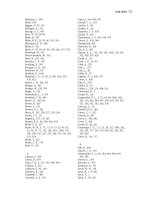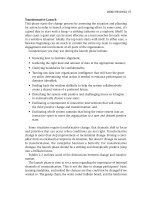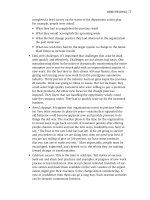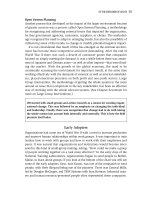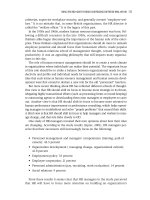practicing organization development a guide for consultants
Bạn đang xem bản rút gọn của tài liệu. Xem và tải ngay bản đầy đủ của tài liệu tại đây (6.97 MB, 753 trang )
TeAM
YYeP
G
Digitally signed by
TeAM YYePG
DN: cn=TeAM
YYePG, c=US,
o=TeAM YYePG,
ou=TeAM YYePG,
email=yyepg@msn.
com
Reason: I attest to
the accuracy and
integrity of this
document
Date: 2005.06.16
05:42:19 +08'00'
About This Book
Why is this topic important?
Organization development (OD) is about planned change. As change has turned into
the only constant, many managers and other people are pursuing change strategies
with vigor. OD is a major strategy for leading and managing change at the individ-
ual, group, intergroup, organizational, interorganizational, and large systems levels.
This book is about what it takes to be an effective change manager, change leader,
and OD consultant.
What can you achieve with this book?
Simply stated, this book provides everything you need to think through on how to func-
tion as a competent OD professional.
How is this book organized?
The book is organized into five parts. Part 1 consists of Chapters 1 through 7 and is
entitled “Foundations.” It includes information on key terms and definitions, models,
origins of OD, and practitioner competencies. Part 2 consists of Chapters 8 through 13
and is entitled “Steps to Guide Planned Change.” This section covers marketing,
pre-launch, launch, implementation, evaluation, and separation. Part 3 consists of
Chapters 14 through 19 and is entitled “Levels of Organizational Change.” In it we dis-
cuss the issue of organization culture and interventions across various levels: individ-
ual, team, large systems, and interlevel. Part 4, the final part of the book, addresses
some special issues in OD: global OD, values, appreciative inquiry, human systems
dynamics, technology, consultant issues, and looking to the future.
The book concludes with three appendices that offer a variety of supplementary
information, including a self-assessment tool for OD competencies. The CD-ROM that
accompanies this book provides reproducible slides, as well as copies of the appendices
and resource lists.
01_962384 ffirs.qxd 2/3/05 5:50 PM Page i
01_962384 ffirs.qxd 2/3/05 5:50 PM Page ii
About Pfeiffer
Pfeiffer serves the professional development and hands-on resource needs of
training and human resource practitioners and gives them products to do their
jobs better. We deliver proven ideas and solutions from experts in HR devel-
opment and HR management, and we offer effective and customizable tools
to improve workplace performance. From novice to seasoned professional,
Pfeiffer is the source you can trust to make yourself and your organization
more successful.
Essential Knowledge Pfeiffer produces insightful, practical, and
comprehensive materials on topics that matter the most to training
and HR professionals. Our Essential Knowledge resources translate the expertise
of seasoned professionals into practical, how-to guidance on critical workplace
issues and problems. These resources are supported by case studies, worksheets,
and job aids and are frequently supplemented with CD-ROMs, websites, and
other means of making the content easier to read, understand, and use.
Essential Tools Pfeiffer’s Essential Tools resources save time and
expense by offering proven, ready-to-use materials—including exercises,
activities, games, instruments, and assessments—for use during a training
or team-learning event. These resources are frequently offered in loose-leaf or
CD-ROM format to facilitate copying and customization of the material.
Pfeiffer also recognizes the remarkable power of new technologies in
expanding the reach and effectiveness of training. While e-hype has often
created whizbang solutions in search of a problem, we are dedicated to
bringing convenience and enhancements to proven training solutions. All our
e-tools comply with rigorous functionality standards. The most appropriate
technology wrapped around essential content yields the perfect solution for
today’s on-the-go trainers and human resource professionals.
Essential resources for training and HR professionals
www.pfeiffer.com
01_962384 ffirs.qxd 2/3/05 5:50 PM Page iii
Other Practicing Organization Development Titles
Finding Your Way in the Consulting Jungle: A Guidebook
for Organization Development Practitioners
Arthur M. Freedman and Richard E. Zackrison
Facilitating Organization Change: Lessons from Complexity Science
Edwin E. Olson and Glenda H. Eoyang
Appreciative Inquiry: Change at the Speed of Imagination
Jane Magruder Watkins and Bernard J. Mohr
Beyond Change Management: Advanced Strategies
for Today’s Transformational Leaders
Dean Anderson and Linda Ackerman Anderson
The Change Leader’s Roadmap: How to Navigate Your Organization’s Transformation
Linda Ackerman Anderson and Dean Anderson
Guiding Change Journeys: A Synergistic Approach to Organization Transformation
Rebecca Chan Allen
Balancing Individual and Organizational Values: Walking the Tightrope to Success
Ken Hultman with Bill Gellermann
The Conscious Consultant: Mastering Change from the Inside Out
Kristine Quade and Renée M. Brown
Organization Development and Consulting: Perspectives and Foundations
Fred Massarik and Marissa Pei-Carpenter
Relationships That Enable Enterprise Change:
Leveraging the Client-Consultant Connection
Ron A. Carucci, William A. Pasmore, and the Colleagues of Mercer Delta
Rewiring Organizations for the Networked Economy: Organizing,
Managing, and Leading in the Information Age
Stan Herman, Editor
The Innovation Equation: Building Creativity and Risk Taking in Your Organization
Jacqueline Byrd and Paul Lockwood Brown
Consulting to Family Businesses: A Practical Guide
to Contracting, Assessment, and Implementation
Jane Hilburt-Davis and W. Gibb Dyer, Jr.
Organization Development at Work: Conversations
on the Values, Applications, and Future of OD
Margaret Wheatley, Robert Tannenbaum, Paula Yardley Griffin,
Kristine Quade, and Organization Development Network
Enterprise-Wide Change: Superior Results Through Systems Thinking
Stephen Haines, Gail Aller-Stead, and Jim McKinlay
01_962384 ffirs.qxd 2/3/05 5:50 PM Page iv
Practicing Organization
Development
A Guide for Consultants
Second Edition
Edited by William J. Rothwell
Roland L. Sullivan
∂
∂
01_962384 ffirs.qxd 2/3/05 5:50 PM Page v
Copyright © 2005 by John Wiley & Sons, Inc.
Published by Pfeiffer
An Imprint of Wiley.
989 Market Street, San Francisco, CA 94103-1741 www.pfeiffer.com
Except as specifically noted below, no part of this publication may be reproduced, stored in a
retrieval system, or transmitted in any form or by any means, electronic, mechanical, photo-
copying, recording, scanning, or otherwise, except as permitted under Section 107 or 108 of the
1976 United States Copyright Act, without either the prior written permission of the Publisher,
or authorization through payment of the appropriate per-copy fee to the Copyright Clearance
Center, Inc., 222 Rosewood Drive, Danvers, MA 01923, 978-750-8400, fax 978-646-8600, or on
the web at www.copyright.com. Requests to the Publisher for permission should be addressed
to the Permissions Department, John Wiley & Sons, Inc., 111 River Street, Hoboken, NJ 07030,
201-748-6011, fax 201-748-6008, e-mail:
Certain pages from this book and all the materials on the accompanying CD-ROM are designed
for use in a group setting and may be customized and reproduced for educational/training pur-
poses. The reproducible pages are designated by the appearance of the following copyright
notice at the foot of each page:
Practicing Organization Development, 2nd Ed Copyright © 2005 by John Wiley & Sons, Inc.
Reproduced by permission of Pfeiffer, an Imprint of Wiley. www.pfeiffer.com
This notice may not be changed or deleted and it must appear on all reproductions as printed.
This free permission is restricted to limited customization of the CD-ROM materials for your
organization and the paper reproduction of the materials for educational/training events. It
does not allow for systematic or large-scale reproduction, distribution (more than 100 copies per
page, per year), transmission, electronic reproduction or inclusion in any publications offered
for sale or used for commercial purposes—none of which may be done without prior written
permission of the Publisher.
For additional copies/bulk purchases of this book in the U.S. please contact 800-274-4434.
Pfeiffer books and products are available through most bookstores. To contact Pfeiffer directly
call our Customer Care Department within the U.S. at 800-274-4434, outside the U.S. at 317-572-
3985 or fax 317-572-4002 or visit www.pfeiffer.com.
Pfeiffer also publishes its books in a variety of electronic formats. Some content that appears in
print may not be available in electronic books.
Printed in the United States of America
ISBN: 0-7879-6238-4
Library of Congress Cataloging-in-Publication Data
Practicing organization development : a guide for consultants / edited by William J.
Rothwell, Roland Sullivan.— 2nd ed.
p. cm.
Rev. ed. of: Practicing organization development / edited by William J. Rothwell, Roland
Sullivan, Gary N. McLean. c1995.
Includes bibliographical references and index.
ISBN 0-7879-6238-4 (alk. paper)
1. Organizational change—Management. 2. Business consultants—Handbooks, manuals,
etc. I. Rothwell, William J., date- II. Sullivan, Roland. III. Practicing organization develop-
ment.
HD58.8.P7 2005
658.4’063—dc22
2004022754
Acquiring Editor: Matthew Davis
Director of Development: Kathleen Dolan Davies
Developmental Editor: Susan Rachmeler
Editor: Rebecca Taff
Senior Production Editor: Dawn Kilgore
Manufacturing Supervisor: Becky Carreno
Printing 10 987654321
01_962384 ffirs.qxd 2/3/05 5:50 PM Page vi
vii
CONTENTS
Contents of the CD-ROM x
List of Exhibits, Tables, Figures, and Tables xii
Dedication xv
Acknowledgments xvii
Statement of the Board xix
Foreword xxiii
Introduction 1
PART ONE: FOUNDATIONS 7
1. Organization Development 9
William J. Rothwell and Roland L. Sullivan
2. Models for Change 39
William J. Rothwell and Roland L. Sullivan
3. On the Shoulders of Giants: The Origins of OD 81
Billie T. Alban and John J. Scherer
4. Using the HRD Audit to Build Convergence Between Human
Resource Management and Organization Development 106
T.V. Rao and William J. Rothwell
∂
∂
02_962384 ftoc.qxd 2/3/05 12:01 AM Page vii
5. Competencies of OD Practitioners 135
Christopher G. Worley, William J. Rothwell, and Roland L. Sullivan
6. Organization Development from the View of the Experts:
Summary Results 164
D.D. Warrick
7. A Future-Responsive Perspective for Competent Practice in OD 188
Saul Eisen, Jeanne Cherbeneau, and Christopher G. Worley
PART TWO: STEPS TO GUIDE PLANNED CHANGE 209
8. Marketing OD 211
Alan Weiss
9. Pre-Launch 238
David W. Jamieson
10. Launch: Assessment and Action Planning 271
By D.D. Warrick
11. Implementation and Continuing the Change Effort 313
W. Warner Burke
12. Evaluation 327
Gary N. McLean and Steven H. Cady
13. Separation 354
W. Warner Burke and Ann Van Eron
PART THREE: LEVELS OF ORGANIZATIONAL CHANGE 363
14. Taking Organization Culture Seriously 365
Edgar Schein
15. Person-Centered OD Interventions 376
Udai Pareek, John J. Scherer, and Lynn Brinkerhoff
16. Team Building: Past, Present, and Future 403
W. Gibb Dyer, Jr.
17. Interventions in Large Systems 420
Thomas G. Cummings and Anne E. Feyerherm
18. Whole System Transformation: The Five Truths of Change 440
Steven H. Cady and Kathleen D. Dannemiller
19. OD Through Interlevel Dynamics 456
David Coghlan
VIII CONTENTS
02_962384 ftoc.qxd 2/3/05 12:01 AM Page viii
PART FOUR: SPECIAL ISSUES IN OD 465
20. Global Organization Development 467
Gary N. McLean, Karen J. Davis, Mila N. Baker, and Juana Anguita
21. Values, Ethics, and Practice in the
Field of Organization Development 493
Terri Egan and William Gellermann
22. Bringing Every Mind into the Game to Realize the Positive
Revolution in Strategy: The Appreciative Inquiry Summit 510
Frank J. Barrett, David L. Cooperrider, and Ronald E. Fry
23. Human Systems Dynamics: Competencies in a Complex World 539
Glenda H. Eoyang
24. Technology and Organization Development 550
Soren Kaplan
25. The Personhood of the Consultant:
The OD Practitioner as Human Being 583
Robert Tannenbaum with Saul Eisen
26. Adding to the Complexity of Personal Change 607
Kristine Quade
27. Practicing Internal OD 620
Allan Foss, David Lipsky, Allen Orr, Beverly Scott, Terrence Seamon, Julie
Smendzuik-O’Brien, Anna Tavis, Dale Wissman, and Catherine Woods
28. Our Work for the Times in Which We Live 646
Margaret Wheatley
Appendix I. A Self-Assessment Tool for OD Competencies 656
Christopher G. Worley, William J. Rothwell, and Roland L. Sullivan
Appendix II. Future OD Practice and Practitioner Competencies 664
Saul Eisen
About the Editors 673
About the Contributing Authors 675
About the Series Editors 693
About the Board Members 695
Subject Index 697
Name Index 710
How to Use the CD-Rom 718
Pfeiffer Publications Guide 719
CONTENTS IX
02_962384 ftoc.qxd 2/3/05 12:01 AM Page ix
x
CONTENTS OF THE CD-ROM
I. PowerPoint Presentations and Media
Slides to Accompany the Book
World Vision Case (to play, select index.html or player.html)
Competency Presentation to Linkage
Competency Presentation to Boston OD Network
Internal and External Partnerships
II. Sample Syllabus for an Introduction to OD Course
III. Outlines from the Chapters for Use in Preparing Lectures
IV. Various Competency Lists
Competency List: Version 20
Competency List: Version 14
AU/NTL Competencies
Guidelines for Entry Level Competencies
IAF Competencies
Competencies for Facilitating Summits
Competencies for Change Leaders
OD Skills and Knowledge—Sheppard Study
V. Bibliographies
Use of Self
Link to Bowling Green ODC Bibliography
∂
∂
02_962384 ftoc.qxd 2/3/05 12:01 AM Page x
CONTENTS OF THE CD-ROM XI
VI. Stories from OD Elders
John Adams
Peter Block
Juanita Brown
Don Cole
Saul Eisen
Art Freedman
Stephen Jenks
Frederick A. Miller
Udai Pareek
Larry Porter
Charles Seashore
Edie Seashore
Marvin Weisbord
VII. Papers, Articles
Dick Beckhard’s Principles for Being a Change Agent
The Social Construction of Reality
Changing the Language of Change
The History of OD and the NTL Institute
The Business Process of Change
A Contemporary Definition of OD
VIII. Organization Change and Development Websites
IX. From the Book
Appendix I: A Self-Assessment Tool for OD Competencies
Appendix II: Future OD Practice and Practitioner Competencies
Exhibit 1.1: A Worksheet for Reflecting on Your Assumptions
Figure 3.1: Origins of OD Time-Line
Exhibit 10.1: Organization Assessment and Action Planning
Guidelines
Exhibit 10.2: Fundamentals of Building Successful Organizations
Exhibit 10.5: Sample Interview Questions
Exhibit 10.6: Culture Assessment
Exhibit 10.7: Change Management Checklist
Exhibit 10.9: Change Planning Form
Exhibit 12.3: Survey to Determine Satisfaction with a Team Meeting
Process
Exhibit 15.1: Sample Executive Development Assessment
Exhibit 16.1: Team Building Checklist I
Exhibit 16.2: Team Building Checklist II
02_962384 ftoc.qxd 2/3/05 12:01 AM Page xi
xii
LIST OF EXHIBITS, FIGURES, AND TABLES
Exhibit 1.1 A Worksheet for Reflecting on Your Assumptions 11
Figure 1.1 A Model of a System 26
Exhibit 1.2 Comparison of Systems and Non-Systems Behavior 28
Exhibit 1.3 Characteristics of Likert’s Four Types of Organizations 31
Exhibit 2.1 The Critical Research Model 41
Figure 2.1 The Traditional Action Research Model 42
Figure 2.2 The Mohr/Jacobsgaard Four I Model of Appreciative
Inquiry 54
Figure 2.3 A New View of the Action Research Model 56
Figure 2.4 Sullivan/Rothwell Change Process Model 58
Exhibit 2.2 Distinctions Between Organization Change and
Transformation 62
Figure 2.5 Three Models of the Change Process 76
Figure 3.1 Origins of OD Time-Line 84
Exhibit 4.1 Checklist of Audit Documents 125
Exhibit 4.2 Sample HRD Audit Scorecard 126
Table 5.1 Sample Demographics 142
Table 5.2 Section-by-Section Results 145
Table 5.3 Pooled-Item Analysis Results 146
Table 5.4 Comparison of Competency Clusters 147
Table 5.5 Comparison of Final Competencies with Other Competency
Studies 155
∂
∂
02_962384 ftoc.qxd 2/3/05 12:01 AM Page xii
Exhibit 6.1 Respondents and Questions Asked in the 2002–2003
Study 165
Exhibit 6.2 Respondents and Questions Asked in the 1978 Study 166
Exhibit 6.3 Frequently Cited OD Definitions 167
Exhibit 6.4 Sampling of Definitions from the 2002–2003 Study 169
Exhibit 6.5 Defining Organization Development 172
Exhibit 6.6 Characteristics of OD 174
Exhibit 6.7 OD Values 175
Exhibit 6.8 Relevancy of OD in Today’s Times 176
Exhibit 6.9 OD Competencies 179
Exhibit 6.10 Best of the Newer Contributions 181
Exhibit 6.11 Major Issues Facing OD 183
Exhibit 7.1 Research on the Future of OD 191
Exhibit 7.2 Delphi Panel Participants 192
Exhibit 8.1 The Rainmaker Attributes 213
Figure 8.1 Three Areas and Four Conditions for Value 214
Figure 8.2 The “Gravity” Concept of Marketing OD Services 216
Exhibit 8.2 Trade Associations 221
Figure 8.3 Conceptual Agreement as the Key to Closing New
Business 229
Exhibit 10.1 Organization Assessment and Action Planning
Guidelines 275
Exhibit 10.2 Fundamentals of Building Successful Organizations 280
Exhibit 10.3 Advantages and Disadvantages of Organization Assessment
Methods 288
Exhibit 10.4 Interviewing Guidelines 292
Exhibit 10.5 Sample Interview Questions 293
Exhibit 10.6 Culture Assessment 296
Figure 10.1 The Planned Change Process 304
Exhibit 10.7 Change Management Checklist 305
Exhibit 10.8 Change Management Principles 306
Exhibit 10.9 Change Planning Form 308
Exhibit 10.10 Roles in Successfully Managing Change 311
Exhibit 11.1 French and Bell’s Typology of OD Interventions 320
Figure 12.1 The OD Cube 328
Figure 12.2 Organization Development Research Variables—Process 329
Figure 12.3 Organization Development Research Variables—Outcomes 330
Figure 12.4 Organization Development Evaluation Model 331
Exhibit 12.1 Advantages and Disadvantages to Possible Evaluators 334
Exhibit 12.2 Sample Items from an OD Process Satisfaction Survey 338
Exhibit 12.3 Survey to Determine Satisfaction with a Team Meeting
Process 339
LIST OF EXHIBITS, FIGURES, AND TABLES XIII
02_962384 ftoc.qxd 2/3/05 12:01 AM Page xiii
Exhibit 12.4 Comparison of Advantages for Customized vs. Standardized
Surveys 341
Figure 12.5 Components for Facilitating a Healthy Feedback Session 349
Figure 15.1 Three Levels of Personal Development 379
Exhibit 15.1 Sample Executive Development Assessment 399
Exhibit 16.1 Team-Building Checklist I 411
Exhibit 16.2 Team-Building Checklist II 412
Figure 17.1 Model of a Large System 422
Figure 18.1 An Integrated View of the Five Truths 445
Figure 19.1 Systemic Interlevel Change 457
Figure 19.2 Phases and Levels of Change 460
Figure 20.1 Corporate World View 481
Exhibit 22.1 A Sampling of Research Related to Appreciative Inquiry 534
Figure 24.1 Level of Engagement and Action 557
Exhibit 24.1 A Collaborative Online Environment 557
Figure 24.2 Relationship/Task Continuum 563
Table 24.1 Collaborative Groups 568
Figure 24.3 Goals, Social Architecture, and Technical Architecture 570
Table 24.2 Online Resources 571
Table 24.3 Synchronous Tools 572
Table 24.4 Asynchronous Tools 573
Figure 25.1 A Model of Self-As-Instrument 586
Figure 25.2 The Johari Window 588
Figure 26.1 The Active Change Model 608
Figure 26.2 Perceiving 609
Table 26.1 Industrial Mindset vs. Emergent Mindset 611
Figure 26.3 Describing 613
Figure 26.4 Accepting 614
Figure 26.5 Questioning 615
Figure 26.6 Acting 617
Figure 26.7 Changing 618
Exhibit 27.1 Interview Questions 622
Exhibit 27.2 Areas of Responsibility 626
Table 27.1 Organization Life Cycle and OD Function 630
Table 27.2 Competencies Reported by Internal OD Practitioners as
Critical to Their Success 634
Table 27.3 Advantages and Challenges of the Internal OD
Practitioner 638
Exhibit 27.3 Rules for Living Inside 641
Table 27.4 Comparison of Internal and External Consulting Roles 642
XIV LIST OF EXHIBITS, FIGURES, AND TABLES
02_962384 ftoc.qxd 2/3/05 12:01 AM Page xiv
Personal Dedications
William J. Rothwell dedicates this book to his wife, Marcelina Rothwell, and to
his daughter, Candice Rothwell. Their love, zest for life, and practical outlooks
have always served as his inspiration. And they give proof to the song lyric
“girls just want to have fun.”
Roland Sullivan dedicates this book to his daughter, Arielle, brother,
Thomas, and centric mentors: Dr. Sivananda of Rishikesh, Dr. Jack Gibb,
Richard Beckhard, Dr. Bob Tannenbaum, Ms. Kathleen Dannemiller, and Dr.
David Cooperrider.
Professional Dedications
The editors dedicate this book to Kathleen Dannemiller for:
• Co-inventing Real Time Strategic Change and Real Time Work Design
(now called Whole-Scale Change) approaches to magically move organiza-
tions to new states;
• Being a passionate advocate of empowerment, engagement, and systems
theory for more than thirty years;
• Believing that there is no conversation that is above or beneath anyone
and that everyone needs to have a voice in shaping the future; and
• Being recognized worldwide for her ability to move an entire system in
large group interactive events forward with speed, depth, and spirit.
We also dedicate this book to Edgar Schein for:
• Co-founding and then being the major lead (with Richard Beckhard and
Warren Bennis) in documenting the theory and practice of the new field of
OD in its start-up phase via the well-known Addison-Wesley Series;
• Being one of the first to articulate the constraints of the consultant’s role as
expert and advisor, and for articulating the then-new notion that the con-
sultant should help others discover what they need and then with sensitiv-
ity facilitate them toward their desired state;
• Helping the field of organization change and development become aware
that results in change efforts come largely from the design, facilitation,
and management of processes;
• Making the concept of “process consultation” a household word among
change agents; and
• His contributions while being a Sloan Fellows Professor of Management
Emeritus and Senior Lecturer at MIT’s Sloan School of Management and
through his countless articles and books.
∂
∂
∂
03_962384 flast.qxd 2/3/05 12:15 AM Page xv
03_962384 flast.qxd 2/3/05 12:15 AM Page xvi
xvii
∂
∂
ACKNOWLEGMENTS
N
o book is the product of its author(s) or editor(s) alone. This book is no
different. Accordingly, we would especially like to thank Dr. Don Cole,
president of the Organization Development Institute, for his support of this
project. Although he did not see the many drafts of this work, he was support-
ive of it. It was his original idea to define the knowledge and skill necessary for
competence in OD.
We also want to thank the participating authors for their willingness to write
their chapters and respond to our repeated demands for revisions. However, we
must accept ultimate responsibility for any mistakes or misstatements made in
this volume because we read all the chapters and revised them so as to main-
tain consistent writing styles.
Finally, William J. Rothwell acknowledges the helpful contributions of his
talented Chinese graduate assistant, Ms. Wei (Aleisha) Wang, in tracking down
and securing copyright permissions as necessary for the busy contributing
authors. Helping her in that task was an equally talented Korean graduate assis-
tant, Yeonsoo Kim. He would also like to thank Wei Wang and another gradu-
ate assistant, Tiffani Payne, for their devoted assistance in rereading the entire
manuscript to ensure that many typographical errors were avoided during the
editing process.
William J. Rothwell
University Park, Pennsylvania
Roland Sullivan
Deephaven, Minnesota
03_962384 flast.qxd 2/3/05 12:15 AM Page xvii
03_962384 flast.qxd 2/3/05 12:15 AM Page xviii
xix
∂
∂
PRACTICING ORGANIZATION
CHANGE AND DEVELOPMENT
SERIES BOARD STATEMENT
O
n behalf of the advisory board, I am pleased to be a part of and to support
the (re)launching of the Practicing Organization Change and Development
Series. The series editors, the publishers, and the advisory board vigor-
ously discussed and debated the series’ purpose, positioning, and delivery. We
challenged extant assumptions about the field of organization change, change
management, and organization development; we argued about perspectives on
relevance, theory, and practice; and we agreed that there’s a story that needs to
be told through a series of books about change. In this first board statement, I
want to relate—as best I can—our rationale for re-naming the series, describe
our purpose, and position this book in the series.
The most obvious change in this re-launching is the series title. We argued
and agreed that it should be changed from “Practicing Organization Develop-
ment: The Change Agent Series for Groups and Organizations” to the “Practic-
ing Organization Change and Development Series.” While that may be the most
obvious change, it is certainly not the most significant one. Our discussion and
debates led us to the firm belief that organization development (OD) was only
03_962384 flast.qxd 2/3/05 12:15 AM Page xix
one method of organization change, that OD was misunderstood by many to
be synonymous with organization change and change management, that OD’s
reputation is at best fragmented, that the field could not be defined by tools and
techniques but had to embrace the entirety of the social and behavioral sciences,
and that the series we wanted to be the advisory board for should be of the
highest quality in terms of both theory and practice. Ultimately, we agreed that
the books in this series should redefine the field of organization change and
development in the broadest sense and should describe the best of innovative
approaches to organization change and development.
A good example of our intent to redefine the field is to compare and contrast
OD and change management. While both are concerned with change, the labels
do describe their intent and philosophy. Organization development is concerned
with development, growth, learning, and effectiveness. It is based primarily in
the behavioral sciences. Change management, on the other hand, is concerned
with implementation, control, performance, and efficiency. It is borne out of re-
engineering and project management perspectives. Our view was that organi-
zation leaders would be best served by a series that embraced and integrated a
variety of views on change. “Good” change in a global economy cannot be
defined only by amounts and levels of participation, by costs (or people)
reduced or profits achieved, or increases in organization size.
The first book in the series re-launching, Practicing Organization Development,
is a good example of this purpose. It represents an initial step to define one
boundary of the field of organization change and development. Written from the
OD perspective, it proposes that good change is more often participatory than
dictated, more concerned with learning and growth than performance, and more
dependent on the behavioral sciences than economics. To be sure, the field of
organization change and development is broader than the perspective described
here. However, this first installment in the series does represent a practical, state-
of-the-art description of the OD perspective.
In addition to redefining the field, we believed that the series should be written
for and by practitioners interested in facilitating effective organizational change.
Books should be grounded but not constrained by theory and practice and geared
to providing advice on the practical issues and applications facing organizations
and their leaders. Again, Practicing Organization Development reflects our
intended purpose. It is written by some of the best scholar-practitioners in the
field. The authors have the standing to describe best practice authoritatively.
Finally, the chapters in this book are grounded in both theory and practice.
Our hope is that this series will raise the level of debate about organization
change and development and that it will be of great assistance to change prac-
titioners and organization leaders entrusted with growth, development, and per-
formance of organizations. We hope you agree that this book is a good start.
—Christopher G. Worley
XX BOARD STATEMENT
03_962384 flast.qxd 2/3/05 12:15 AM Page xx
Series Editors
Kristine Quade
Roland L. Sullivan
William J. Rothwell
Advisory Board
Ed Schein, Series Consultant
David L. Bradford
W. Warner Burke
Lenneal Henderson
Edith Whitfield Seashore
Christopher G. Worley
BOARD STATEMENT XXI
03_962384 flast.qxd 2/3/05 12:15 AM Page xxi
03_962384 flast.qxd 2/3/05 12:15 AM Page xxii
xxiii
∂
∂
FOREWORD
OD: A PROMISE YET TO BE REALIZED
Building on a sound research base from the behavioral sciences, OD started in
the 1960s with great promise. From the early Hawthorne studies and then
expanded by the work of Argyris, French, McGregor, Likert, Marrow, Maslow,
and others, OD appeared to open up an entirely new way to produce change
and to manage organizations. Research in the laboratory and the field suggested
that:
• Expertise is not just held by the experts, but exists throughout the orga-
nization—especially by those who are closest to the problem.
• “Resistance to change” doesn’t have to be a given. When people are
involved in the change process, not only does cooperation increase, but
the quality of the outcome dramatically improves.
• It is possible to not only solve the problem at hand, but the very process
of dealing with difficult, even contentious issues can significantly
increase individual, team, and organizational ability to function more
effectively. That is the development in OD.
Organizations ranging from such major corporations as Esso, TRW, Alcan,
P&G, and General Foods to religious organizations (such as the Episcopal
03_962384 flast.qxd 2/3/05 12:15 AM Page xxiii

